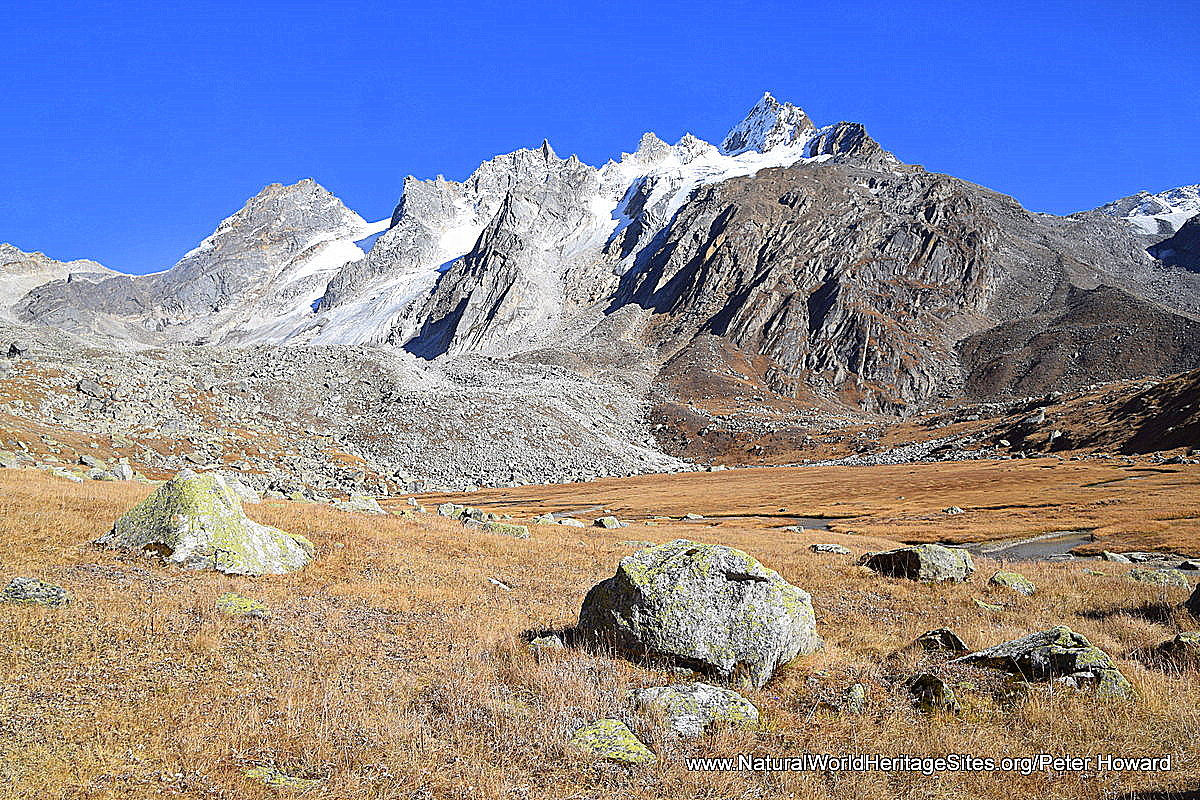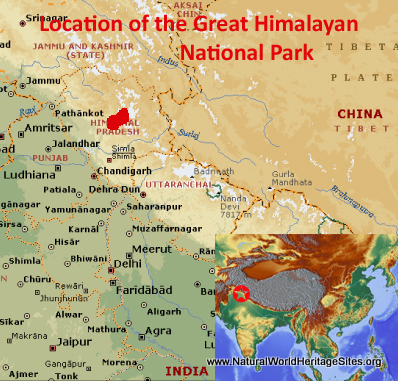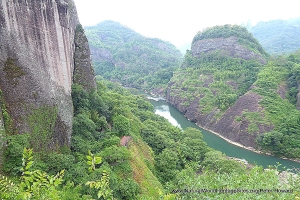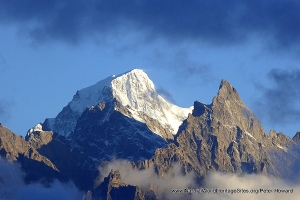EXPLORE THE GREAT HIMALAYAN NATIONAL PARK CONSERVATION AREA with this slideshow, check the location map and get all the facts and information below.
For slideshow description see right or scroll down (mobile). Click to view slideshow
Location and Values: The Great Himalayan National Park Conservation Area is located in the western Himalayas and forms part of a wider protected landscape, covering an enormous diversity of habitats and ranging in altitude from below 2000m to over 6000m. Its global significance is for biodiversity, especially for the protection of species associated with the temperate forests at lower altitudes (which have been mostly destroyed in other areas of the Himalayas). Some 58% of its broad-leafed plant species (angiosperms) are endemic to the western Himalayas and the area supports important populations of endangered species such as the western tragopan (a brightly plumed pheasant) and musk deer.
Conservation Status and Prospects. According to IUCN’s Conservation Outlook Assessment (2017) the conservation status of the Great Himalayan National Park Conservation Area is ‘good with some concerns’. The IUCN report notes that ‘ the property is legally well-protected and managed as a single unit under a single management plan spanning the period 2010-2020. There are currently no significant threats to the Great Himalayan National Park Conservation Area however, careful monitoring and management is necessary to mitigate negative impacts from human occupation within the Sainj WLS and the adjoining Ecozone which acts as a buffer zone. Efforts to enable rights-based conservation approaches should continue including the phasing out of grazing within Tirthan WLS and strengthening where possible consistently high levels of legal protection across the property. The context of the Great Himalayan National Park Conservation Area within a larger complex of protected lands bodes well for its conservation outlook and provides opportunities for progressive expansion of the property. Monitoring, especially of populations of key species, needs a technological upgrade and third-party involvement in order to understand trends and also design research studies that can correlate negative trends with impacts of climate change and other threats. Management interventions need to be based more on researched findings and with reliable monitoring protocols.
Links:
Google earth
Official UNESCO Site Details
IUCN Conservation Outlook
UNEP-WCMC Site Description
Slideshow description
The slideshow is intended to ‘tell the story’ of the Great Himalayan National Park Conservation Area, and features a portfolio of photos from an 8-day trekking expedition led by Peter Howard in October 2017. The expedition was guided and supported by a team of six local community members organized by Himalayan Ecotourism, and followed the course of the Tirthan River valley from Gushaini to the high peaks at the head of the valley. The return route followed a slightly different path via an upland meadow at Nada Thach surrounded by ancient broadleaf forests of golden oak and rhododendron. The slideshow is arranged chronologically from start to finish, up and down the valley. It illustrates the diversity of forest types and ecological communities experienced during the trek, with each vegetation ‘zone’ determined primarily by altitude, from the broadleaf riverine forests at lower altitudes through various types of coniferous forest and above the tree-line into the alpine meadows and grasslands below the rocky peaks and glaciers. The biodiversity is illustrated with photos of a few of the large mammals encountered along the way (grey langur monkeys and Bharal/Himalayan blue sheep), some of the flowers, birds (Himalayan Griffon vulture), butterflies, fungi and lichens, many of which remain undocumented in the park literature. Religion plays an important role in local culture and many of the prominent natural features (caves, boulders, ancient trees) are revered, festooned in prayer flags and serve as places of worship.
Tourism is still in its infancy in the Great Himalayan National Park Conservation Area, and although the lower reaches of the picturesque Tirthan valley (below the park boundary) is a popular destination, very few visitors make anything more than a day trek into the Great Himalayan National Park. A graded path has been developed for the more adventurous trekkers as far as Nada Thach (half way up the valley), but trekking conditions above this are primitive and require total self-sufficiency – and a healthy tolerance of risk. During our 8-day expedition we did not encounter any other person for 7 days, so became a tight-knit and convivial team by the end of the expedition (including an adorable stray dog that accompanied us throughout!).
Factfile
Website Category: Mountains
Area: 905 km2
Inscribed: 2014
Criteria:
- Natural habitat for biodiversity (x);
- Significant number of rare, endemic and/or endangered species (x)





